SEORadar: Product Overview
Changes are happening to your site all the time and you’re not always informed. It could be code changes you didn’t want to happen, like pushing a noindex from staging to production. Or, it could be changes that aren’t as drastic, but you still need to be informed. With engineers, designers, product managers, marketing managers, and content writers impacting a website, the delicate balance that is required for SEO is at risk.
That’s where SEORadar comes in. We monitor your website for differences and alert you to SEO impactful changes with email, Slack or text alerts. You may think of us an auditing tool. We are, but we are dramatically different from the other tools and applications you may find. It starts with HTML snapshots. We capture, archive and analyze your HTML. This full source archive (both fetched and rendered) enables SEORadar’s unique capabilities.
SEORadar Demo
See how detailed diff monitoring can protect your site and make your life so much easier!
HTML Snapshots and Archive
We start off by taking a snapshot of your HTML. Most SEOs and product managers have a tough time knowing exactly how their pages changed in the last release, not to mention going back a month or two or more to investigate a change to an important metric. The snapshot is the key that allows us to do things that other audit tools can't. For instance a line by line comparison of the full HTML, content or SEO elements (like this):
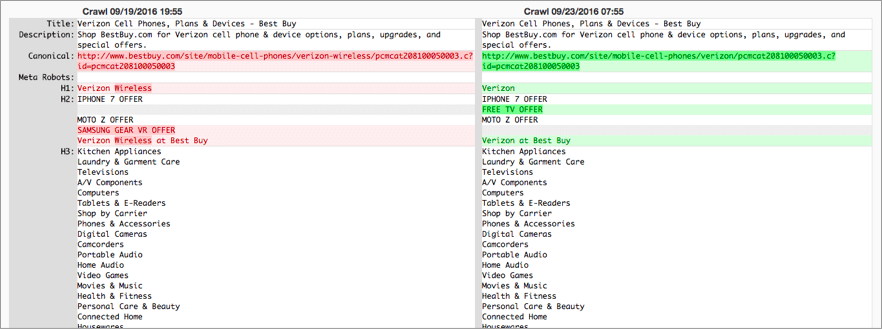
We archive the following data for up to 15 months:
- Full HTML - you can produce structured diff, a full HTML diff or a content diff
- Server Response
- Alerts - we save all alerts and crawls so you know exactly what happened to your pages and when
- Screenshots
- DOM - - we now save the DOM and allow you to diff the DOM vs the server HTML
Intelligent alerts based on change analysis
It's the archive that powers our unique capabilities. By comparing page versions we tell you things that standard audits can't. For example, to know whether titles changed after a new release, you need to manually examine all your titles and compare them to a previous version. Think of all the things you need to verify when a site update is pushed out, we do that for you automatically. For instance:
- A page redirects to a new URL
- A 301 changes to a 302
- An important keyword has been removed from an H1 or a Title
- A footer link has been removed which was linking to important content.
- The destination URL in a canonical link changes or generates a 404 error
- The count of URLs submitted via sitemaps or indexed drops
- A Sitemap is no longer accessible
- And many, many more including meta robots, robots.txt, hreflang tags, opengraph, schemas & custom tests.
Chances are, you want a text alert if one of these critical SEO changes ends up on your home page!
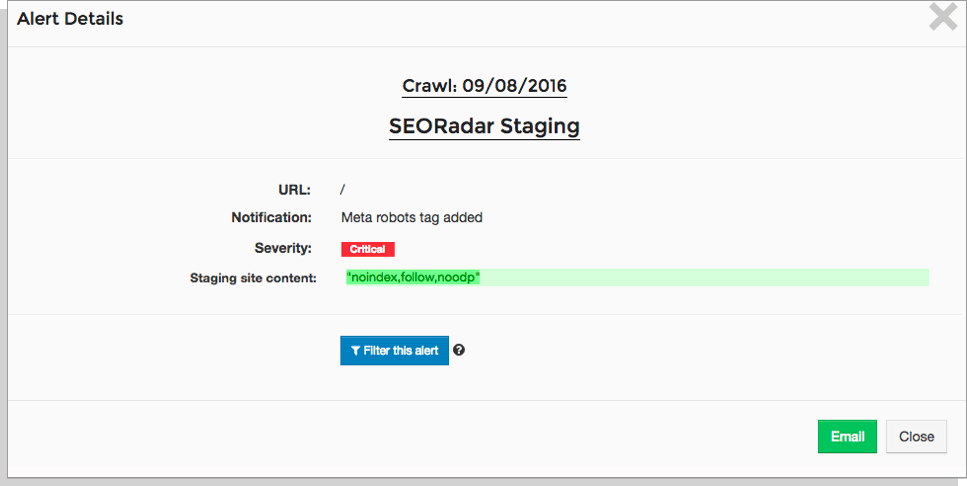
Customized Alerts Priorities
Not all changes are as important as others. With critical, high, medium, and low alert levels, you're able to ensure that the most important alerts are identified above noise. For example, the default priority for a Title change is critical and an H1 change is High. You might want to know about H1 changes but can lower the priority so they don't result in an email. However, for a noindex tag, you might want an email and a text message. Configure the system to meet your own priorities. You can even suppress specific alerts on individual URLs.
Dashboard
Our Dashboard allows you to quickly decide see what domain profiles need attention. You can zoom into the most recent audit, drill into history or trigger a new audit.
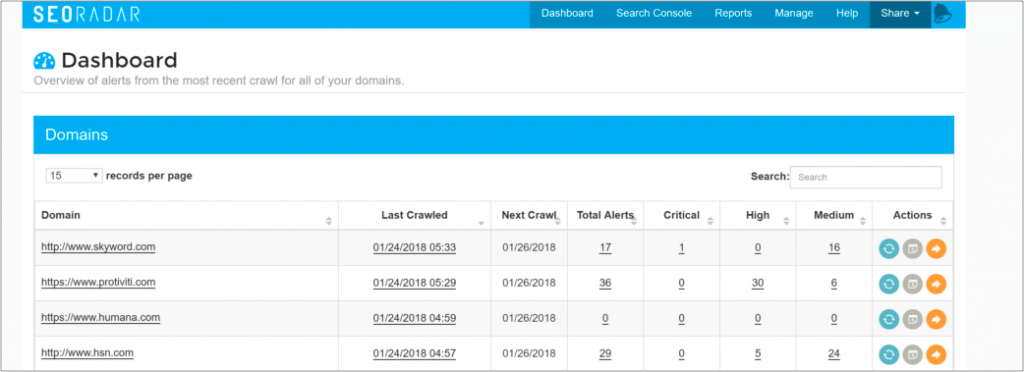
Staging Tests
Let's face it, monitoring is great but it's more important to catch issues before pushing a new version of the site from staging to production. Google is fast and you don't want to have to fight the clock to get problems fixed before Google indexes it. With some plans, you can test staging environments vs production on demand. Our diff alerts and audits will allow the SEO QA person compare changes line by line quickly since every change is highlighted.
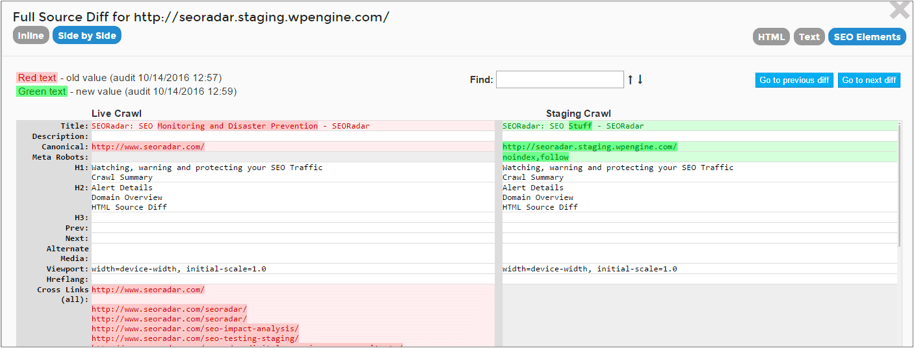
With our handy Chrome extension , we don't even need VPN access.
Give your QA person access to SEORadar and you sure to make his or her life easier!
Competitive Monitoring
Sometimes changes in your performance has nothing to do with your site ... it is something that your competitors did which pushed you down or up
Wouldn't you to know just when your competitors changed their site?
Add your competitors and we will monitor their sites for changes as well and also create an archive of their changes as well.
New, you can create competitive keyword groups. We will change-monitor the URLs that compete for that keyword.
SEORadar Time Machine
A typical issue for an SEO is investigating a traffic drop that might have started a month ago or more. That might mean scouring through release notes to understand what happened. With our archive, you can go back in time and view your pages last week or even months ago. Not only do we save the HTML snapshots, we also store server response and page render metrics. Maybe you page performance has slowly been degrading the last few months. You can tell by looking at the URL history.
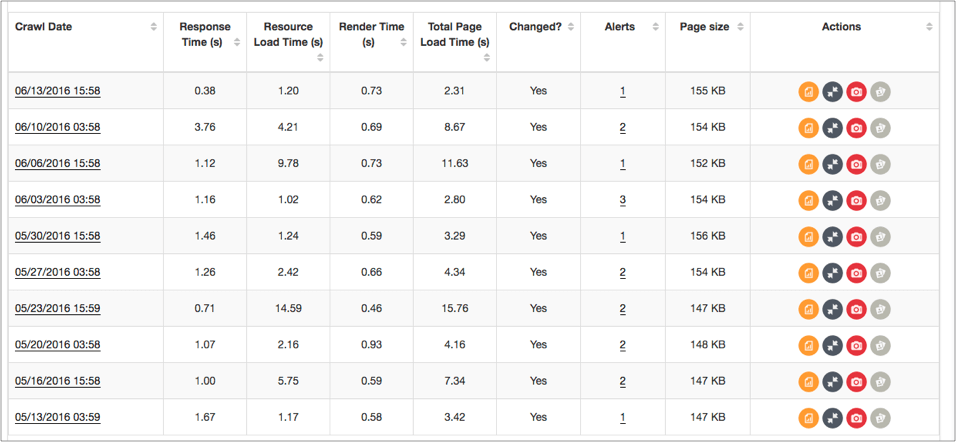
Change Analysis and SEO Testing
On a dynamic website with lots of changes going on, analyzing the impact of all these changes is difficult. This is much more difficult than SEM where the results of a test or a change are nearly immediate. You need to wait for the change to get indexed by Google, give enough time for rankings and traffic metrics to take hold and remember to go back after the fact and analyze the results. You also need to look at other changes that happened over that time period that may have influenced the results. Wouldn't it be great to view a change, flag it for analysis and automatically be notified the results of that analysis after enough time has passed? For instance, suppose a keyword has been removed from an H2. Not critical, but you still want to know the impact. Now you can, simply click the analyze change button viewing an alert:
Next, you set the parameters for the analysis; how much data you want to collect and how long a buffer period you want to give Google to index the change.
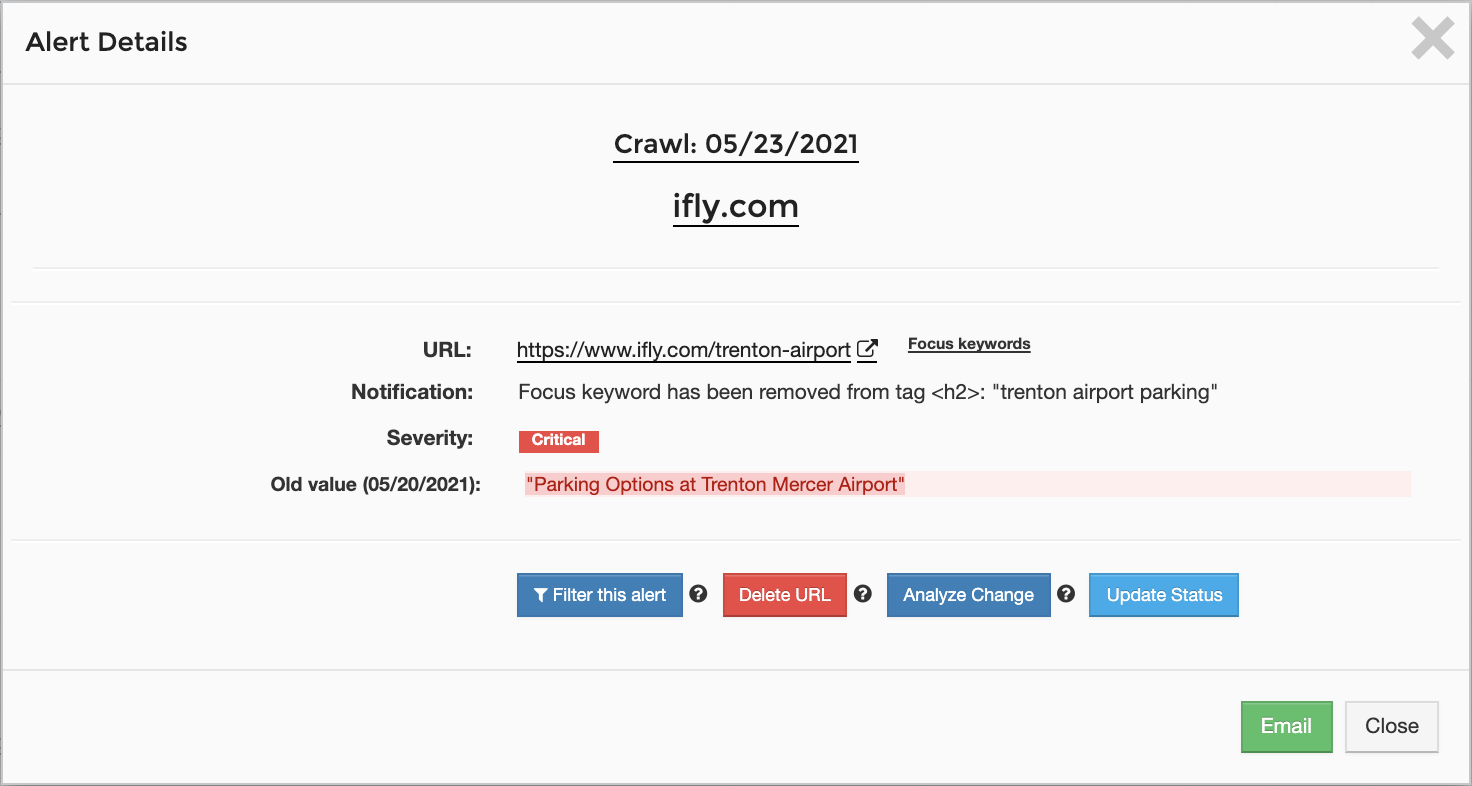
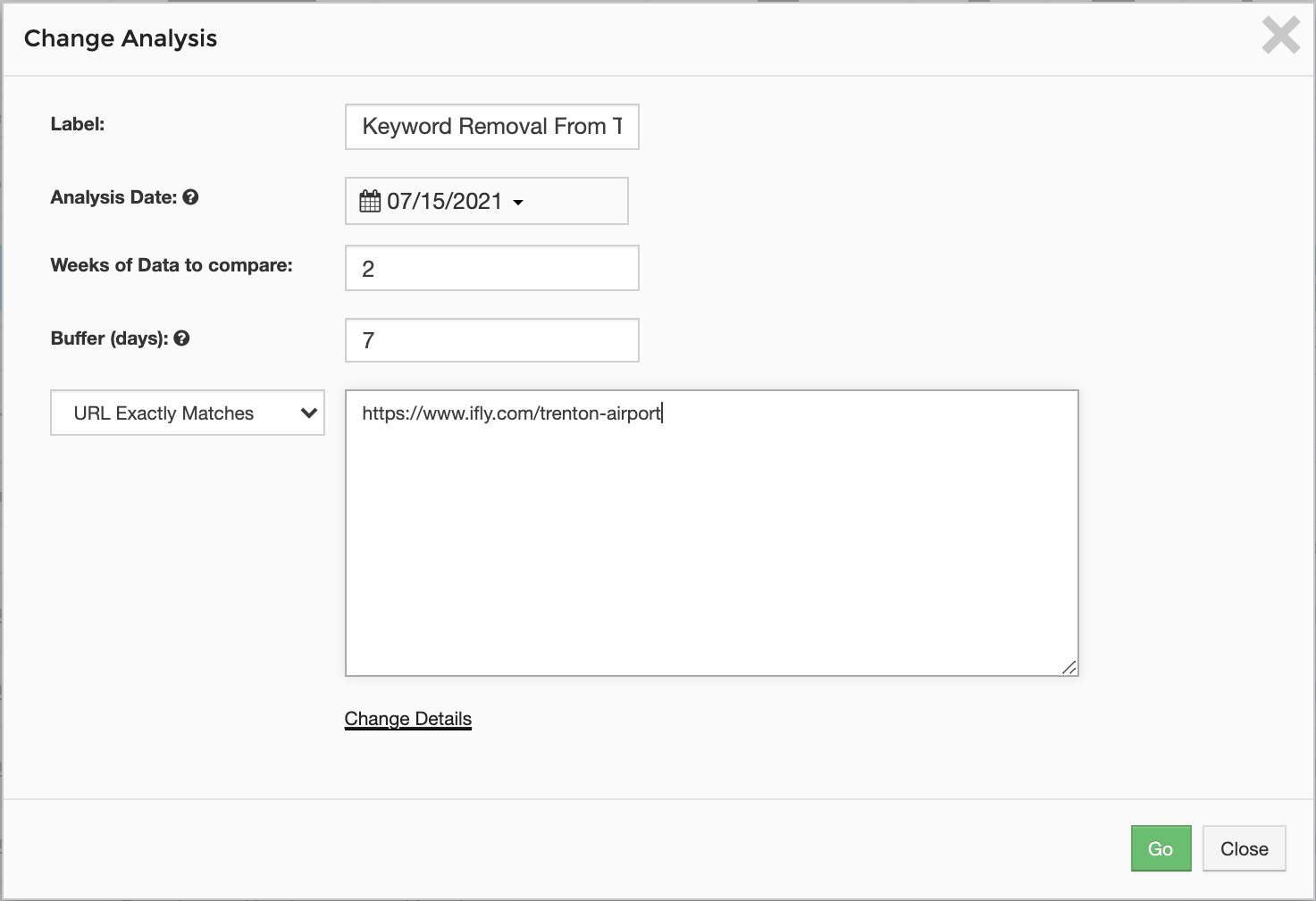
And then ... automagically (via integration with search console) we will generate a report and email you after the data is available, showing you keyword rankings and clicks pre-change vs. post-change:

Custom Alerts
We have a powerful custom alert mechanism which lets you monitor for specific strings of even create xpath expression tests (which will let you monitor a specific page section for a change. Our customers have used this to:
Get alerts when a new review is posted
Monitor their Wikipedia page for updates
Monitoring tag from various analytics products
Monitor code snippets used to advertising units
Mobile vs. Desktop Diffs
Google's coming mobile index makes it critical to audit exactly what is served up to the mobile crawler.
You will now have two distinct indexes to worry about!
Besides the standard change diff report, SEORadar can run a desktop vs.. mobile diff audit. We recommend taking a careful look at differences in mobile content as you prepare for Google's new mobile index. This is especially important if you have an adaptive, m.dot or progressive web app.
Site Migrations and Redirect Testing
If have a site migration coming up, we strongly recommend setting up SEORadar prior to the migration. This way you will have a detailed before and after view of the site!
It is critical that you set up the correct redirects and the redirects continue to work over time so that you don't lose the historical value of the old URL’s
If you have any historic migrations or URL changes that have been done prior to setting up SEORadar, we recommend configuring those old URLs into our redirect tester. We will then continually monitor those URLs so verify that the redirects stay in place.
Extended Search Console Archive
Search console reports are limited to the top 1000 pages or keywords. VIA the API, we have access to as far more data, as much as 10,000+ pages.
While the Search Data is great inside of Search Console, Google only provides that data for 90 days. We archive it for as longs as 12 months with our enterprise version.
Weekly Keyword and Page Winners & Losers Report
Each we will analyze your Search Console data and generate a report of keyword movement and page performance. This quick snapshot will arrive on Monday morning in your inbox and you can go into SEORadar and examine the data in more detail.
See your wins and get early warning on rankings and indexing issues.
Drill into individual pages to analyze performance.

